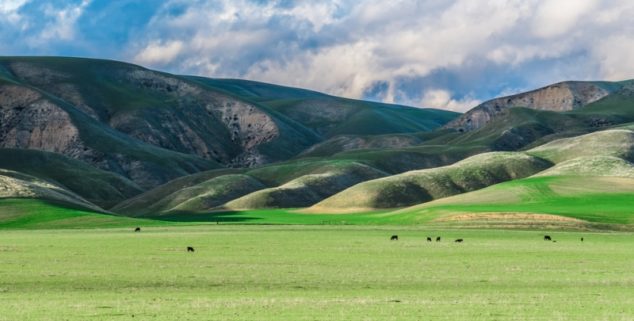Opinion
A wildfire prevention plan: Shorter grass on rangelands
 A landscape shot of grazing range in Central California near the foothills. (Photo: David A. Litman, via Shutterstock)
A landscape shot of grazing range in Central California near the foothills. (Photo: David A. Litman, via Shutterstock)One of the first executive decisions President Joe Biden made in assembling his leadership team was to select a top-level climate adviser whose job is to ensure that climate considerations are embedded into all government policies, not just those with obvious climate implications.
It is an approach that Gov. Gavin Newsom has said California must also embrace as it confronts the horrific impacts of climate-driven wildfires. Late last summer, at a time when five of the six largest wildfires in state history were burning at once, Newson spoke of the need to act “across the entire spectrum” of state policies.
Shorter grasses on rangelands not only reduce the intensity of fire and slow its spread, but they also make it possible for firefighters to act more quickly.
California can take significant climate actions not just in such obvious areas as energy and transportation policy, but also in policy areas that some might find unlikely. It can start with land management – an area in which past shortcomings have contributed to creating our new era of megafires.
The megafires of 2020 blackened an astonishing 4.4 million acres of land. Better land management policies could not only help to prevent fires from spreading so quickly, but also help to reduce the amount of greenhouse gas emissions that spew from those raging blazes – nearly 112 million tons of carbon dioxide into the atmosphere just last year.
Better managing our public lands means reducing the fuels that stoke wildfires. One way to accomplish that is to manage the land more actively by increasing the acreage that can be leased for grazing.
Lest you think that sounds like a small step, it is not.
A study last year by the University of California’s Cooperative Extension found that grazing cattle consume nearly 12 billion pounds of fuel in a year. In some areas of the state, they reduce the amount of fuel by more than 1,000 pounds per acre.
The state can also exert its leadership through an agreement last year to partner with the federal government to improve wildfire resiliency on public forest and rangelands.
It noted there is the potential to increase this fuel reduction, since the number of beef cattle in the state is now only a little more than half what it was in the 1980s. Since then, there have been significant declines in public lands grazing.
Shorter grasses on rangelands not only reduce the intensity of fire and slow its spread, but they also make it possible for firefighters to act more quickly. When flame heights are kept below four feet, it becomes possible for firefighters to access an area from the ground without the use of heavy equipment.
The study’s conclusion: “Cattle grazing plays an important role in reducing fine fuels on grazed rangelands in California.”
The Newsom administration and the Legislature should heed this finding by ensuring that the Department of Natural Resources has maximum flexibility to utilize grazing for the purpose of fuel management, and to award grazing leases in a way that produces the greatest environment outcomes.
The state can also exert its leadership through an agreement last year to partner with the federal government to improve wildfire resiliency on public forest and rangelands. The U.S. government owns nearly 58 percent of California’s 33 million acres of forestlands, while the state owns 3 percent. Joint federal-state management of public lands is crucial to the wildfire resilience.
Grazing isn’t always the appropriate management tool for specific wildlands, but often it can be. The state must utilize this low-tech option wherever possible while also focusing on other important fuel-management strategies, especially controlled burns. It is imperative that good fires be utilized in weather conditions in which they can be managed so that destructive fires become more limited in times of high winds, searing heat and low humidity.
There is no doubt that a changing climate has contributed to the conditions that have made megafires an annual disaster in California, but climate change alone is not the culprit. Poor land management practices have made our lands more susceptible.
If we are to act across the entire spectrum of state policies to combat climate change and its effects, land management must surely be on the agenda.
—
Editor’s Note: Dr. Stephanie Larson is the Livestock & Range Management Advisor for UC Cooperative Extension.
Want to see more stories like this? Sign up for The Roundup, the free daily newsletter about California politics from the editors of Capitol Weekly. Stay up to date on the news you need to know.
Sign up below, then look for a confirmation email in your inbox.

Leave a Reply